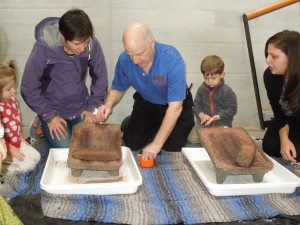
Contemporary Mormons might not be the first group in Utah with a love of chocolate.
On Feb. 8, Utah’s Museum of Natural History opened a new exhibit suggesting chocolate was consumed by Mesoamericans living in villages near the Alkali Ridge as far back as 750 A.D., making Utah the home of America’s oldest known chocolate.
The discovery of pottery belonging to ancestral Puebloan people in southern Utah prompted experts to study the Pueblos further. When researchers discovered traces of cacao on the ancient pottery bowls, they considered the bowls as strong evidence of a migration of people from the south.
Scientists had previously traced the origins of chocolate consumption to the ancient Maya, the first people known to turn the bitter seeds of the cacao into a drink. With the lack of a cacao tree-friendly environment in North America, experts say the existence of cacao on the ancient pottery implies a migration of people from Central America and Mexico.
For many Mormons, discovery of this migration only supports theories they already believed, regarding groups of people in the Book of Mormon living in Mesoamerica.
“What we do know from the Book of Mormon, if we look at Helaman chapter 3 verse 3, is that there was ‘an exceedingly great many who departed out of the land of Zarahemla, and went forth unto the land northward,'” said BYU ancient scripture professor Tyler Griffin.
Kari Steadman, who attended the exhibit with her family, thought it was interesting to see how something as simple as chocolate can, in a sense, help support the validity of the Book of Mormon.
“It’s just really neat to see how science and religion can kind of come together,” Steadman said. “Obviously no one has all the answers yet, but it’s interesting to see how some of the things we have always believed to be true are slowly starting to be supported with evidence.”
The evidence of the migration northward found in the exhibit is not necessarily the same migration referred to in the Book of Mormon.
“There is so much dispersion that we can’t really track down who goes where,” Griffin said. “So we don’t make an official statement one way or another.”
While the exhibit might be particularly noteworthy to Latter-day Saints, Utahns, as well as others from around the world, are finding it fascinating.
“The exhibit actually came to Utah from the Field Museum in Chicago,” said museum employee Ciera Elliot. “And it has been drawing huge crowds ever since it opened here in early February.”
The exhibit is so popular that the chocolate tastings every Wednesday, Saturday and Sunday have been selling out by early afternoon.
“The tastings are extremely popular,” Elliot said. “People will probably want to buy tickets early so they can be sure to get a seat.”
The exhibit will be featured in the Museum of Natural History until June. It is open every day of the week from 10 a.m. to 5 p.m., with extended hours on Wednesdays to 9 p.m. Tickets can be purchased at the door, with prices ranging from $8 to $11. Children under 3 are allowed free admission.
[soundslides width=”620″ height =”533″ id=”360020″]




